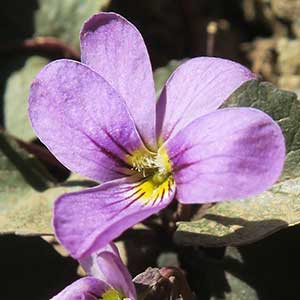Viola flettii
Viola ocellata
Flett's violet, Olympic violet, rock violet
pinto violet, two-eyed violet, western heart's ease, western heart's ease or two-eyed or southern two-eyed violet
1–3, ascending to erect, mostly glabrous, on caudex from fleshy rhizome.
1–3, ascending to erect, ± glabrous or usually puberulent, on caudex from shallow, fleshy rhizome or deep-seated caudex with fleshy roots.
basal and cauline;
basal: 1–3;
stipules linear-lanceolate, margins entire or with glandular processes, apex acuminate;
petiole 1.5–9.7 cm, mostly glabrous;
blade purple-tinted and –veined, broadly reniform to ovate, 0.9–2.4 × 1.2–4 cm, base cordate, margins finely crenate-serrate, eciliate, apex acute to obtuse, surfaces glabrous or sparsely pubescent along veins adaxially;
cauline similar to basal except: stipules ovate to lanceolate, margins entire or shallowly laciniate;
petiole 0.7–5.9 cm, usually glabrous;
blade 0.8–2.1 × 1.2–3.1 cm.
basal and cauline;
basal: 1–6;
stipules deltate, margins laciniate, apex usually long-acuminate;
petiole 3.7–10 cm, puberulent;
blade ovate, deltate, or subreniform, 1–6 × 1.2–4 cm, base usually cordate to subcordate, margins crenate, usually ciliate, apex acute, mucronulate, surfaces usually sparsely puberulent, glabrous early;
cauline similar to basal except: stipules lanceolate, margins ±fimbriate, sometimes stipitate-glandular, sometimes entire, erose, or ± laciniate;
petiole 0.4–9 cm;
blade ovate to deltate, 1.6–4.4 × 1.1–3.6 cm, base subcordate to truncate, margins crenate to ± serrate, ciliate, apex acute to obtuse.
1.8–7.1 cm, usually glabrous.
1–10 cm, puberulent.
sepals lanceolate, margins eciliate, auricles 0.5–1.5 mm;
petals soft reddish violet on both surfaces, all with yellow area basally, lower 3 dark violet-veined, lateral 2 bearded, lowest with white around yellow area, 10–15 mm, spur yellow, gibbous, 0.5–2 mm;
style head bearded; cleistogamous flowers axillary.
sepals lanceolate, margins ciliate, auricles 0.5–1.5 mm;
petals white adaxially, upper 2 and sometimes lower 3 deep reddish violet abaxially, all with yellow area basally, lateral 2 with purple patch basally distal to smaller yellow area, bearded, lowest with yellow patch basally, purple-veined, 5–15 mm, spur yellow or greenish, gibbous, 1–2.5 mm;
style head bearded; cleistogamous flowers axillary.
± spherical, 5–9 mm, glabrous.
spherical to spherical-ovoid, 5–11 mm, minutely scabrous.
dark brown to brownish purple, 2.5–3 mm.
brown-purple, ca. 2 mm.
= 12.
Viola flettii
Viola ocellata
Viola flettii is endemic to the Olympic Mountains of northwestern Washington. C. S. McCreary (2005) noted that although morphologically and ecologically distinct, V. cuneata, V. flettii, and V. ocellata are closely related.
(Discussion copyrighted by Flora of North America; reprinted with permission.)


